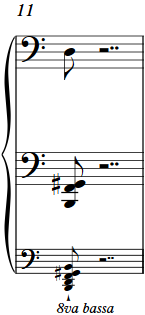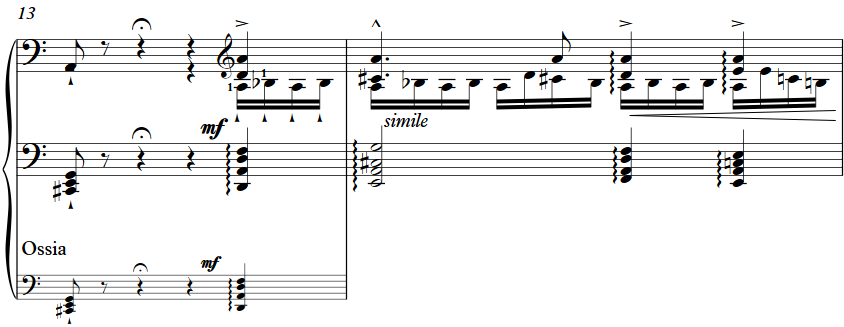


1. “Di rider finirai pria dell' aurora.”
(Your laugh will stop before the day dawns.) With the postscript:
“Ribaldo, audace, lascia ai morti la pace."
(Bold, reckless man let the dead rest.)
This threat, flung from the statue of the murdered Commendatore against Don Giovanni has to be played molto espressivo. �It is followed, in the tenth bar, by the incarnate appearance of the statue itself, after being boldly invited by Don Giovanni.�The designator of this second motif is the heavy and wide syncopated�rhythm of two eerie chords.�Liszt applies this theme three times in the course of the introduction, and so that they always mark the beginning of the sentence, which they belong to.
A crescendo mark, which follows a�ff,�can not be played otherwise than by applying a quieter crescendo that leads back to�ff.� For the benefit of the climax in bar 10, the editor would recommend to play the first�ff with dynamic restraint.

Die Figur der rechten Hand nicht etwa "bravourös-präludierend zu schmeißen: sondern geradezu klirrend (getrennt) Gehör zu bringen; darum das Zeitmaß auszubreiten.

Impressive silence.�(Lift the pedal) the roaring has to stop abruptly.�Unlike Mozart, where the bass B still sounds during two beats.

The same thing, as in bar 11).
From here on, the tempo should be "meno grave", or even "Andante con moto"; the dynamic expression "sotto voce". The editor plays this whole variation (until the next�ff)�like the shadow of its example. The listener has from the terrifying force of the first passage to recover. In short, the section that begins here has to sound in the opposite way, without somehow falling into weakness. A completely measured (almost consistent march) rhythm, a limitation in the use of the pedal, will help contribute efficiently to the required character of this passage.

The�ff almost without transition, unexpectedly.

"Tempestuoso" (stormy, thunderstorm). Liszt applies this expression repeatedly through his entire piano works. It is a light dark nuance of subdued mood that inclines rather to piano. The meaning is probably that of a threat, an approaching, still distant storm: a picturesque idea that is often misunderstood and interpreted even in the opposite way. The evidence for our view provides bar 33, that has clearly the p prescribed.
The pause should last an eighth note.�It translates very expressive the "breathtaking" of the musical (and dramatic) situation.
Copyright © 2014 Inno de Linnep webmaster@delinnep.com